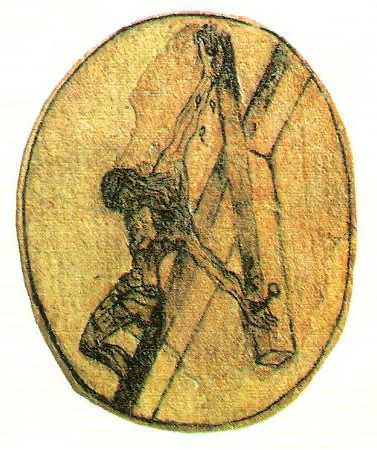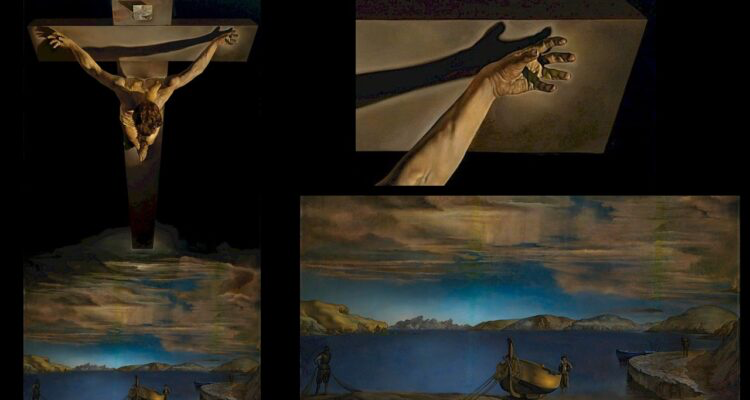Tags

Drawing of the Crucifixion From Above, by John of the Cross in late 1500’s. This influenced Salvador Dali’s “Christ of St. John of the Cross” in 1951 (below).

Salvador Dali: “Christ of St. John of the Cross”
Here is a poem by Englishman Peter Hartley about the Dali painting and the Crucifixion from Above:
I
This crucifixion hides the anguish. Racked
With pain, belied by bloodless hands and feet;
Intolerable torments, they compete
As muscles in that arching back contract.
His hanging head forestalls all eye contact;
And here we see Him, harrowing complete,
As Pilate meted out from judgment seat
Beyond this lorn forsaken barren tract.
And Dali gives us stage-lighting to show
These youthful figures, tinctured gold below,
Are simple fishermen. And there they stand,
Aghast at what they cannot understand:
That Christ the Son of God exalted some
To share His state and close to Him become.
II
Beneath their feet they furl a fishing net,
These figures that we see upon the ground.
Twilight, a nightjar makes its urgent sound
Unseen, a distant double bark offset
By otherwise persistent silence. Yet
Wherewith is this scene lit? The black profound
Above, behind us to our left, all round
Embrowned, kaleidoscopic colours set
To raze the parchèd earth. And these young men
Would never know a jeunesse dorée then,
They flung their nets, repaired them when required,
They ate when hungry, slept when they were tired:
But here we see, their garments flecked with gold,
These young ones mark the new as we the old.
.
III
How can His body hang, no nails to hands
Or feet as Dali has Him here portrayed?
So anodyne this bloodless corpse, conveyed
To blackest heights above the barren lands
Of Israel: the dreadful pain demands
Our awe, the horror that is here betrayed,
That dead weight tortured angle still displayed,
Such agony an infant understands.
But this is not a Cranach and nor yet
A Grünewald. We are not moved today
By horrors that were suffered yesterday.
Inured to Bosch and Brueghel scenes of sweat
And pain, more present horrors that we dread:
The pickled shark and that revolting bed.
IV
How sad to see around us decadence
On such a scale there is no turning back,
No slightest evidence that common sense
Can any more prevail against attack.
We cannot ever get back what we had
And there is no return to where we were,
The world’s artistic cognoscenti mad:
Dali the last hope of the connoisseur?
For he could paint, with sable in his hand.
Only in trompe l’œil is there a demand
That we suspend our disbelief, it’s good
His two dimensions keep his art surreal:
In Emin’s bed, Quinn’s head of frozen blood
The horror and the nastiness are real.
Peter Hartley is a retired painting restorer. He was born in Liverpool and lives in Manchester, UK.
